FORD SUPER DUTY 2014 3.G Diesel Supplement Manual
Manufacturer: FORD, Model Year: 2014, Model line: SUPER DUTY, Model: FORD SUPER DUTY 2014 3.GPages: 82, PDF Size: 3.12 MB
Page 51 of 82
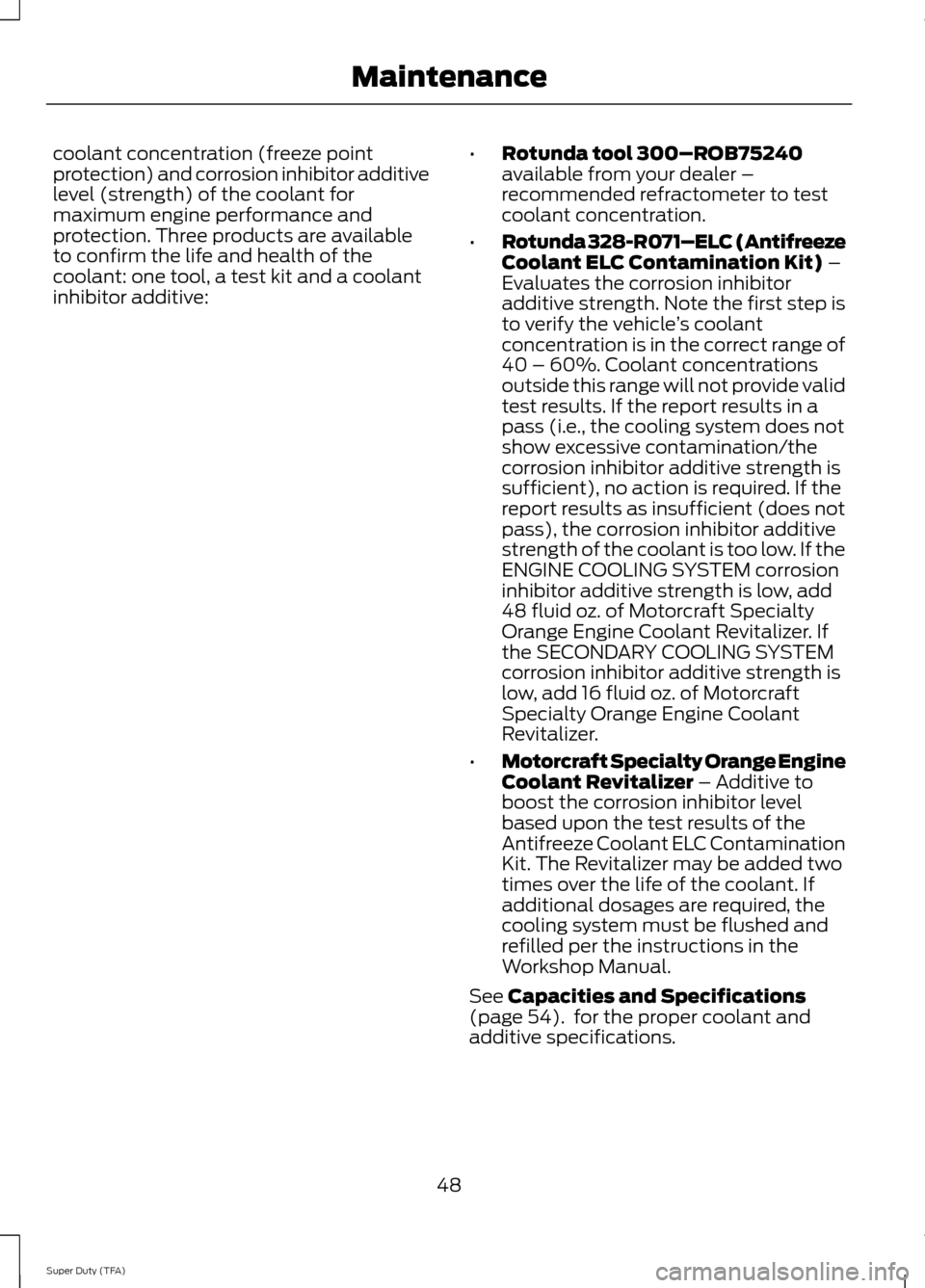
coolant concentration (freeze point
protection) and corrosion inhibitor additive
level (strength) of the coolant for
maximum engine performance and
protection. Three products are available
to confirm the life and health of the
coolant: one tool, a test kit and a coolant
inhibitor additive:
•
Rotunda tool 300–ROB75240
available from your dealer –
recommended refractometer to test
coolant concentration.
• Rotunda 328-R071–ELC (Antifreeze
Coolant ELC Contamination Kit) –
Evaluates the corrosion inhibitor
additive strength. Note the first step is
to verify the vehicle ’s coolant
concentration is in the correct range of
40 – 60%. Coolant concentrations
outside this range will not provide valid
test results. If the report results in a
pass (i.e., the cooling system does not
show excessive contamination/the
corrosion inhibitor additive strength is
sufficient), no action is required. If the
report results as insufficient (does not
pass), the corrosion inhibitor additive
strength of the coolant is too low. If the
ENGINE COOLING SYSTEM corrosion
inhibitor additive strength is low, add
48 fluid oz. of Motorcraft Specialty
Orange Engine Coolant Revitalizer. If
the SECONDARY COOLING SYSTEM
corrosion inhibitor additive strength is
low, add 16 fluid oz. of Motorcraft
Specialty Orange Engine Coolant
Revitalizer.
• Motorcraft Specialty Orange Engine
Coolant Revitalizer
– Additive to
boost the corrosion inhibitor level
based upon the test results of the
Antifreeze Coolant ELC Contamination
Kit. The Revitalizer may be added two
times over the life of the coolant. If
additional dosages are required, the
cooling system must be flushed and
refilled per the instructions in the
Workshop Manual.
See
Capacities and Specifications
(page 54). for the proper coolant and
additive specifications.
48
Super Duty (TFA) Maintenance
Page 52 of 82
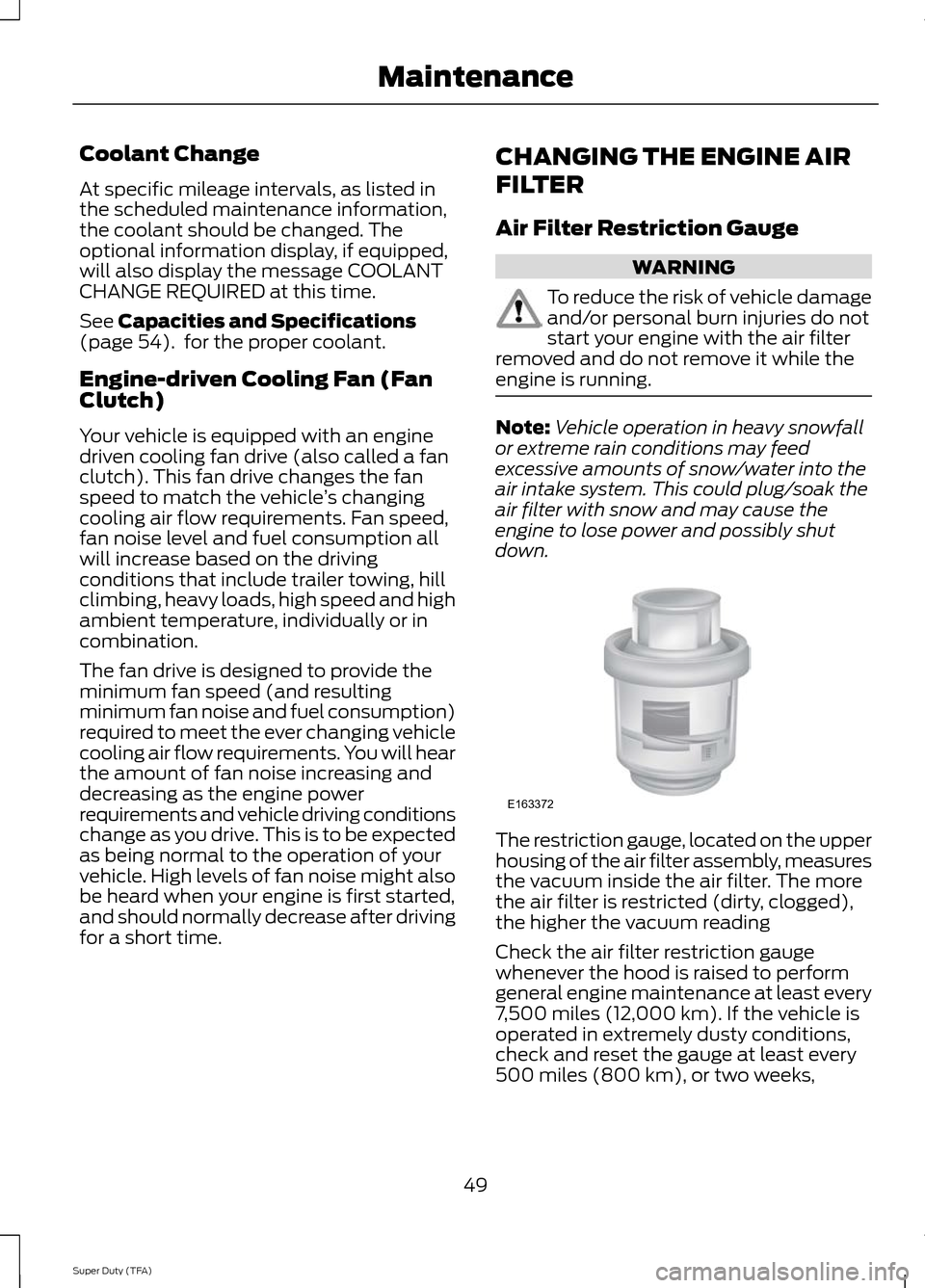
Coolant Change
At specific mileage intervals, as listed in
the scheduled maintenance information,
the coolant should be changed. The
optional information display, if equipped,
will also display the message COOLANT
CHANGE REQUIRED at this time.
See Capacities and Specifications
(page 54). for the proper coolant.
Engine-driven Cooling Fan (Fan
Clutch)
Your vehicle is equipped with an engine
driven cooling fan drive (also called a fan
clutch). This fan drive changes the fan
speed to match the vehicle ’s changing
cooling air flow requirements. Fan speed,
fan noise level and fuel consumption all
will increase based on the driving
conditions that include trailer towing, hill
climbing, heavy loads, high speed and high
ambient temperature, individually or in
combination.
The fan drive is designed to provide the
minimum fan speed (and resulting
minimum fan noise and fuel consumption)
required to meet the ever changing vehicle
cooling air flow requirements. You will hear
the amount of fan noise increasing and
decreasing as the engine power
requirements and vehicle driving conditions
change as you drive. This is to be expected
as being normal to the operation of your
vehicle. High levels of fan noise might also
be heard when your engine is first started,
and should normally decrease after driving
for a short time. CHANGING THE ENGINE AIR
FILTER
Air Filter Restriction Gauge WARNING
To reduce the risk of vehicle damage
and/or personal burn injuries do not
start your engine with the air filter
removed and do not remove it while the
engine is running. Note:
Vehicle operation in heavy snowfall
or extreme rain conditions may feed
excessive amounts of snow/water into the
air intake system. This could plug/soak the
air filter with snow and may cause the
engine to lose power and possibly shut
down. The restriction gauge, located on the upper
housing of the air filter assembly, measures
the vacuum inside the air filter. The more
the air filter is restricted (dirty, clogged),
the higher the vacuum reading
Check the air filter restriction gauge
whenever the hood is raised to perform
general engine maintenance at least every
7,500 miles (12,000 km). If the vehicle is
operated in extremely dusty conditions,
check and reset the gauge at least every
500 miles (800 km), or two weeks,
49
Super Duty (TFA) MaintenanceE163372
Page 53 of 82
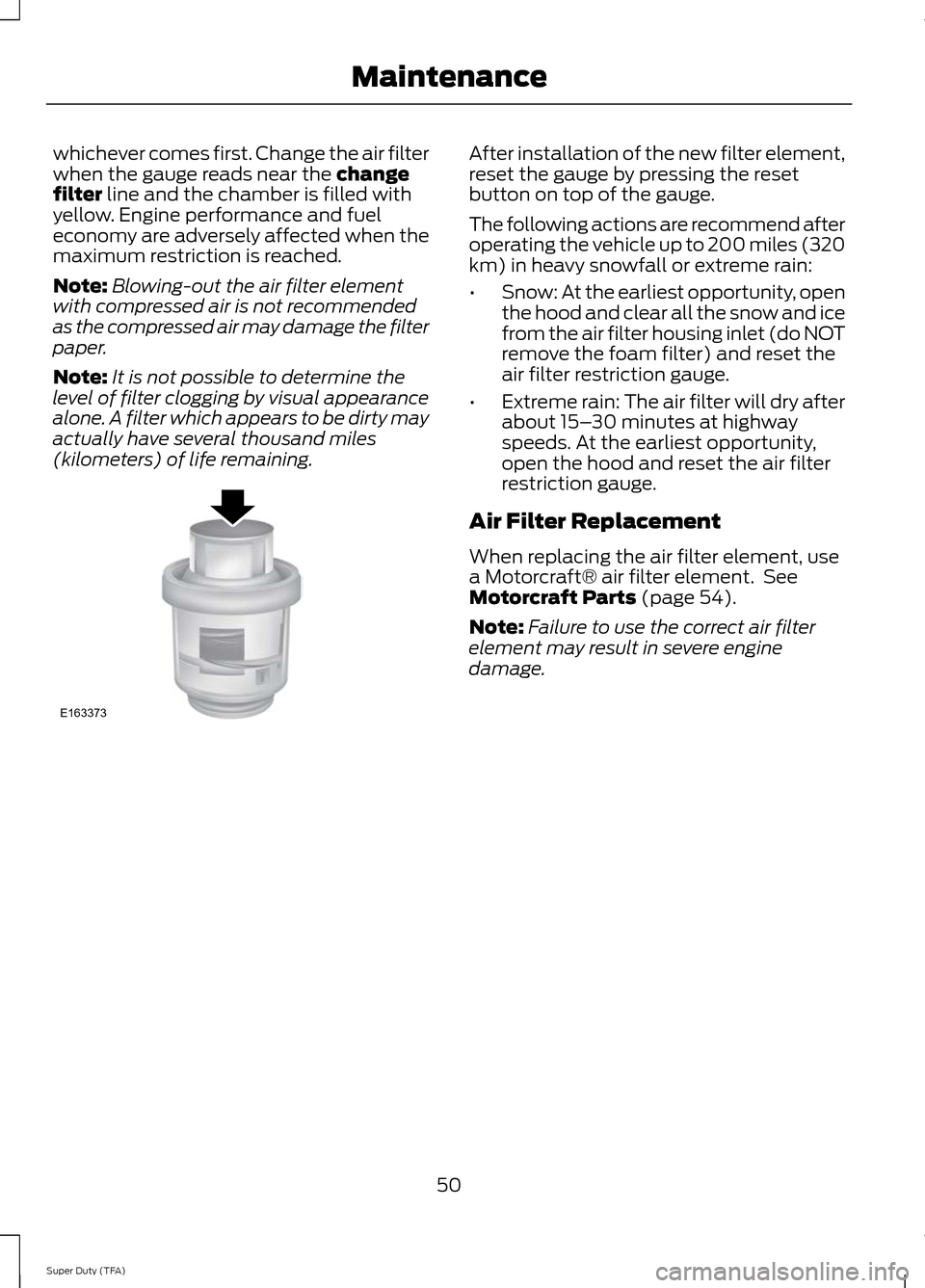
whichever comes first. Change the air filter
when the gauge reads near the change
filter line and the chamber is filled with
yellow. Engine performance and fuel
economy are adversely affected when the
maximum restriction is reached.
Note: Blowing-out the air filter element
with compressed air is not recommended
as the compressed air may damage the filter
paper.
Note: It is not possible to determine the
level of filter clogging by visual appearance
alone. A filter which appears to be dirty may
actually have several thousand miles
(kilometers) of life remaining. After installation of the new filter element,
reset the gauge by pressing the reset
button on top of the gauge.
The following actions are recommend after
operating the vehicle up to 200 miles (320
km) in heavy snowfall or extreme rain:
•
Snow: At the earliest opportunity, open
the hood and clear all the snow and ice
from the air filter housing inlet (do NOT
remove the foam filter) and reset the
air filter restriction gauge.
• Extreme rain: The air filter will dry after
about 15– 30 minutes at highway
speeds. At the earliest opportunity,
open the hood and reset the air filter
restriction gauge.
Air Filter Replacement
When replacing the air filter element, use
a Motorcraft® air filter element. See
Motorcraft Parts
(page 54).
Note: Failure to use the correct air filter
element may result in severe engine
damage.
50
Super Duty (TFA) MaintenanceE163373
Page 54 of 82
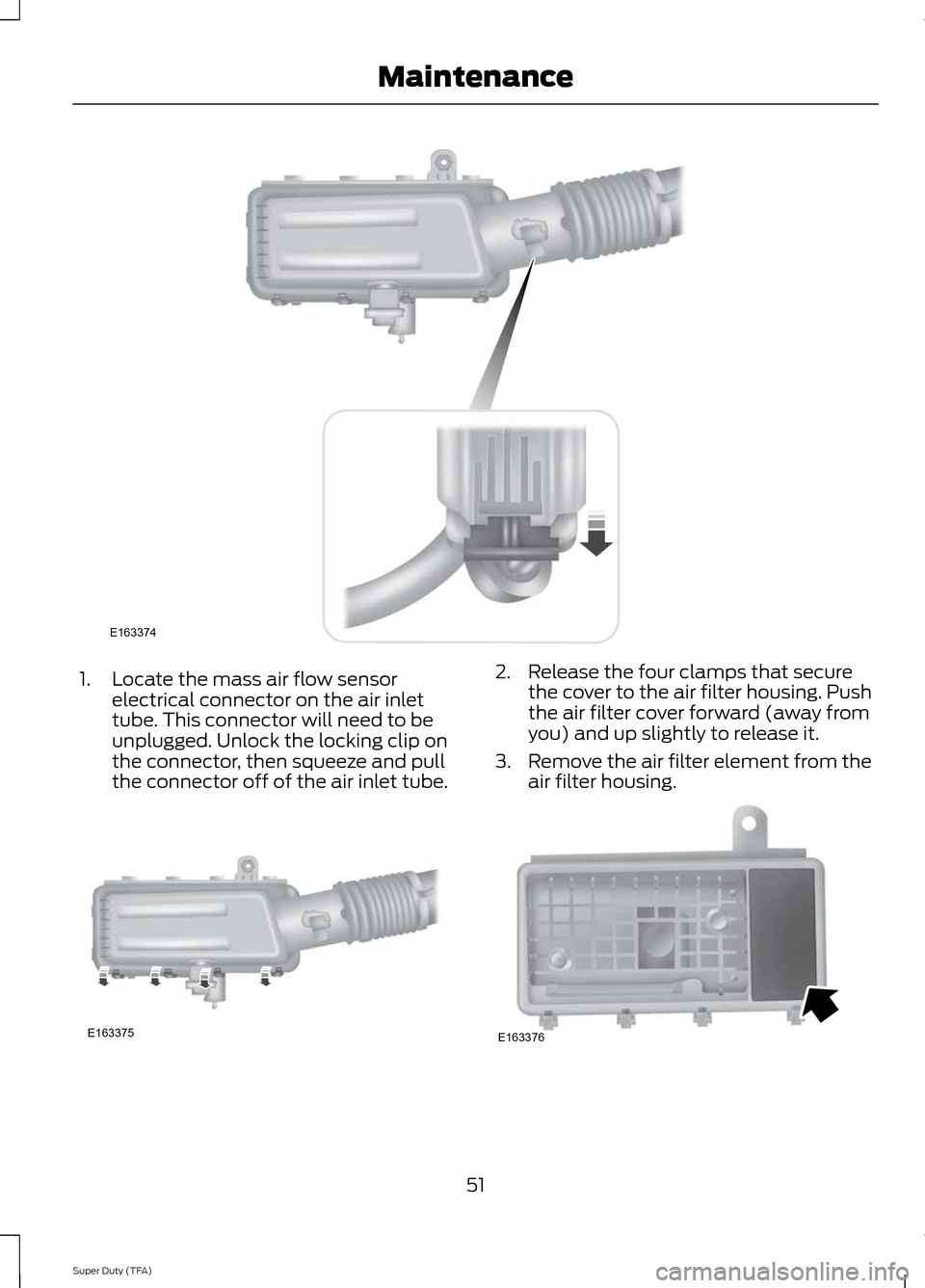
1. Locate the mass air flow sensor
electrical connector on the air inlet
tube. This connector will need to be
unplugged. Unlock the locking clip on
the connector, then squeeze and pull
the connector off of the air inlet tube. 2. Release the four clamps that secure
the cover to the air filter housing. Push
the air filter cover forward (away from
you) and up slightly to release it.
3. Remove the air filter element from the
air filter housing. 51
Super Duty (TFA) MaintenanceE163374 E163375 E163376
Page 55 of 82
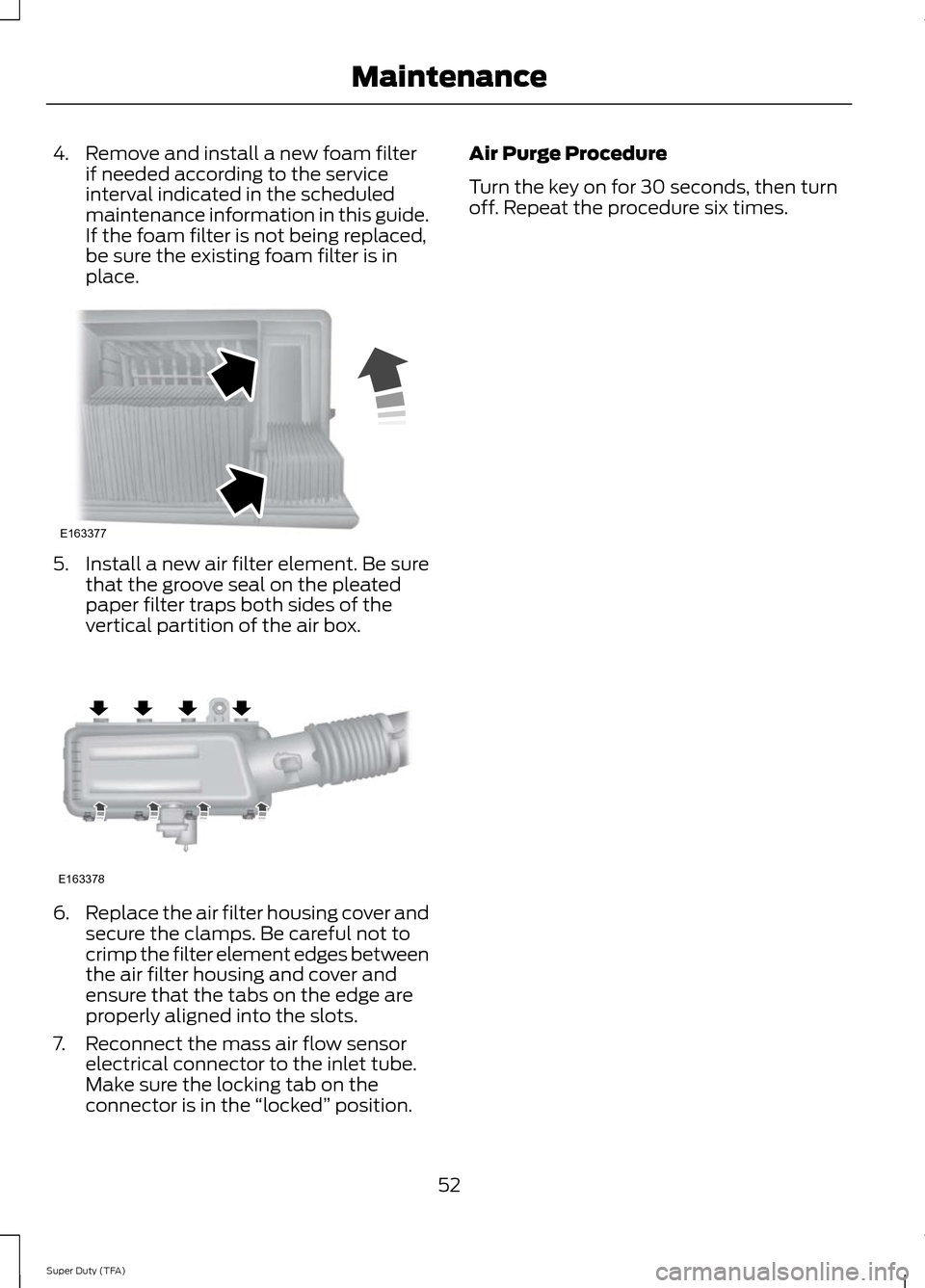
4. Remove and install a new foam filter
if needed according to the service
interval indicated in the scheduled
maintenance information in this guide.
If the foam filter is not being replaced,
be sure the existing foam filter is in
place. 5. Install a new air filter element. Be sure
that the groove seal on the pleated
paper filter traps both sides of the
vertical partition of the air box. 6.
Replace the air filter housing cover and
secure the clamps. Be careful not to
crimp the filter element edges between
the air filter housing and cover and
ensure that the tabs on the edge are
properly aligned into the slots.
7. Reconnect the mass air flow sensor electrical connector to the inlet tube.
Make sure the locking tab on the
connector is in the “locked ” position. Air Purge Procedure
Turn the key on for 30 seconds, then turn
off. Repeat the procedure six times.
52
Super Duty (TFA) MaintenanceE163377 E163378
Page 56 of 82
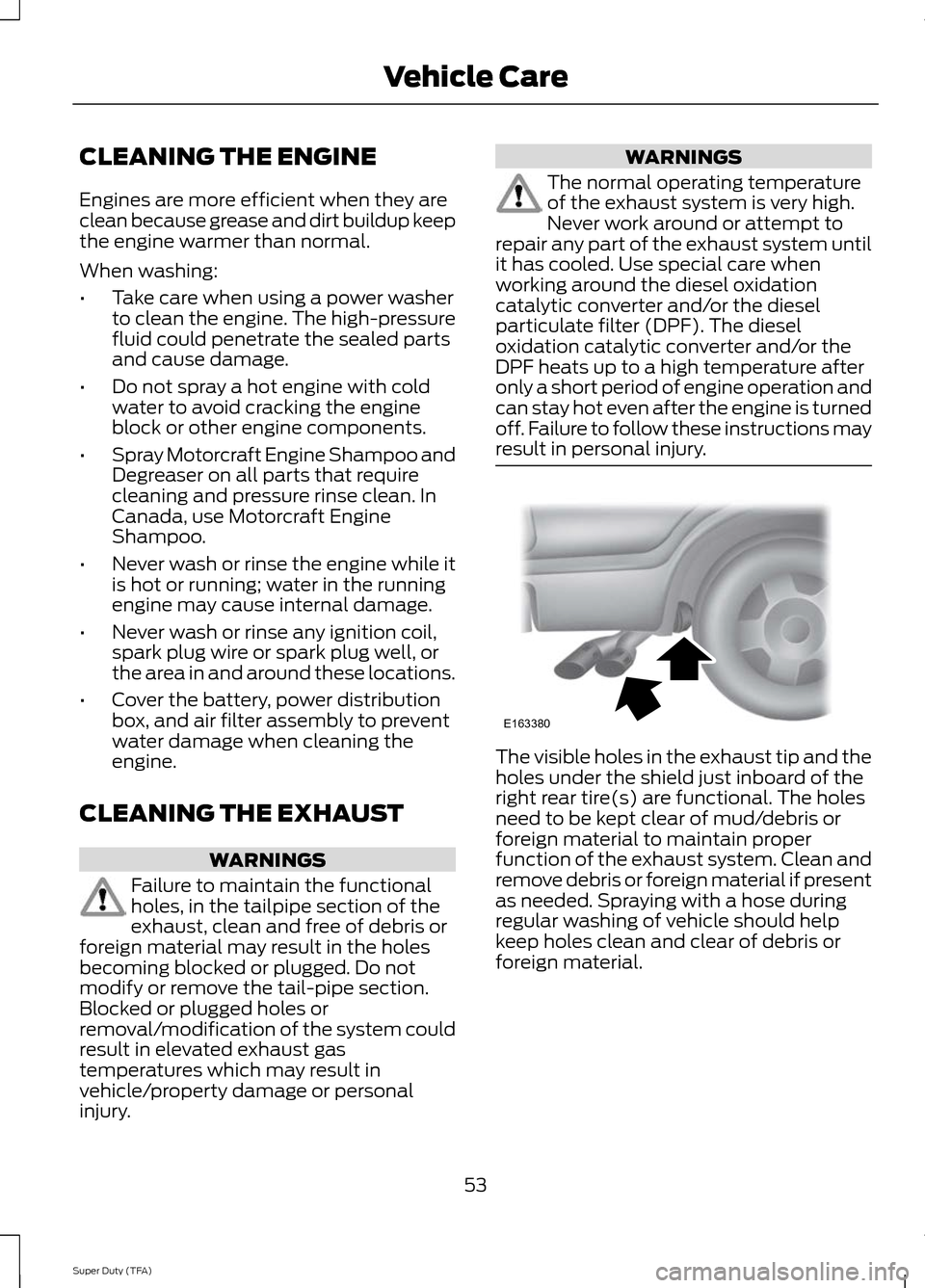
CLEANING THE ENGINE
Engines are more efficient when they are
clean because grease and dirt buildup keep
the engine warmer than normal.
When washing:
•
Take care when using a power washer
to clean the engine. The high-pressure
fluid could penetrate the sealed parts
and cause damage.
• Do not spray a hot engine with cold
water to avoid cracking the engine
block or other engine components.
• Spray Motorcraft Engine Shampoo and
Degreaser on all parts that require
cleaning and pressure rinse clean. In
Canada, use Motorcraft Engine
Shampoo.
• Never wash or rinse the engine while it
is hot or running; water in the running
engine may cause internal damage.
• Never wash or rinse any ignition coil,
spark plug wire or spark plug well, or
the area in and around these locations.
• Cover the battery, power distribution
box, and air filter assembly to prevent
water damage when cleaning the
engine.
CLEANING THE EXHAUST WARNINGS
Failure to maintain the functional
holes, in the tailpipe section of the
exhaust, clean and free of debris or
foreign material may result in the holes
becoming blocked or plugged. Do not
modify or remove the tail-pipe section.
Blocked or plugged holes or
removal/modification of the system could
result in elevated exhaust gas
temperatures which may result in
vehicle/property damage or personal
injury. WARNINGS
The normal operating temperature
of the exhaust system is very high.
Never work around or attempt to
repair any part of the exhaust system until
it has cooled. Use special care when
working around the diesel oxidation
catalytic converter and/or the diesel
particulate filter (DPF). The diesel
oxidation catalytic converter and/or the
DPF heats up to a high temperature after
only a short period of engine operation and
can stay hot even after the engine is turned
off. Failure to follow these instructions may
result in personal injury. The visible holes in the exhaust tip and the
holes under the shield just inboard of the
right rear tire(s) are functional. The holes
need to be kept clear of mud/debris or
foreign material to maintain proper
function of the exhaust system. Clean and
remove debris or foreign material if present
as needed. Spraying with a hose during
regular washing of vehicle should help
keep holes clean and clear of debris or
foreign material.
53
Super Duty (TFA) Vehicle CareE163380
Page 57 of 82
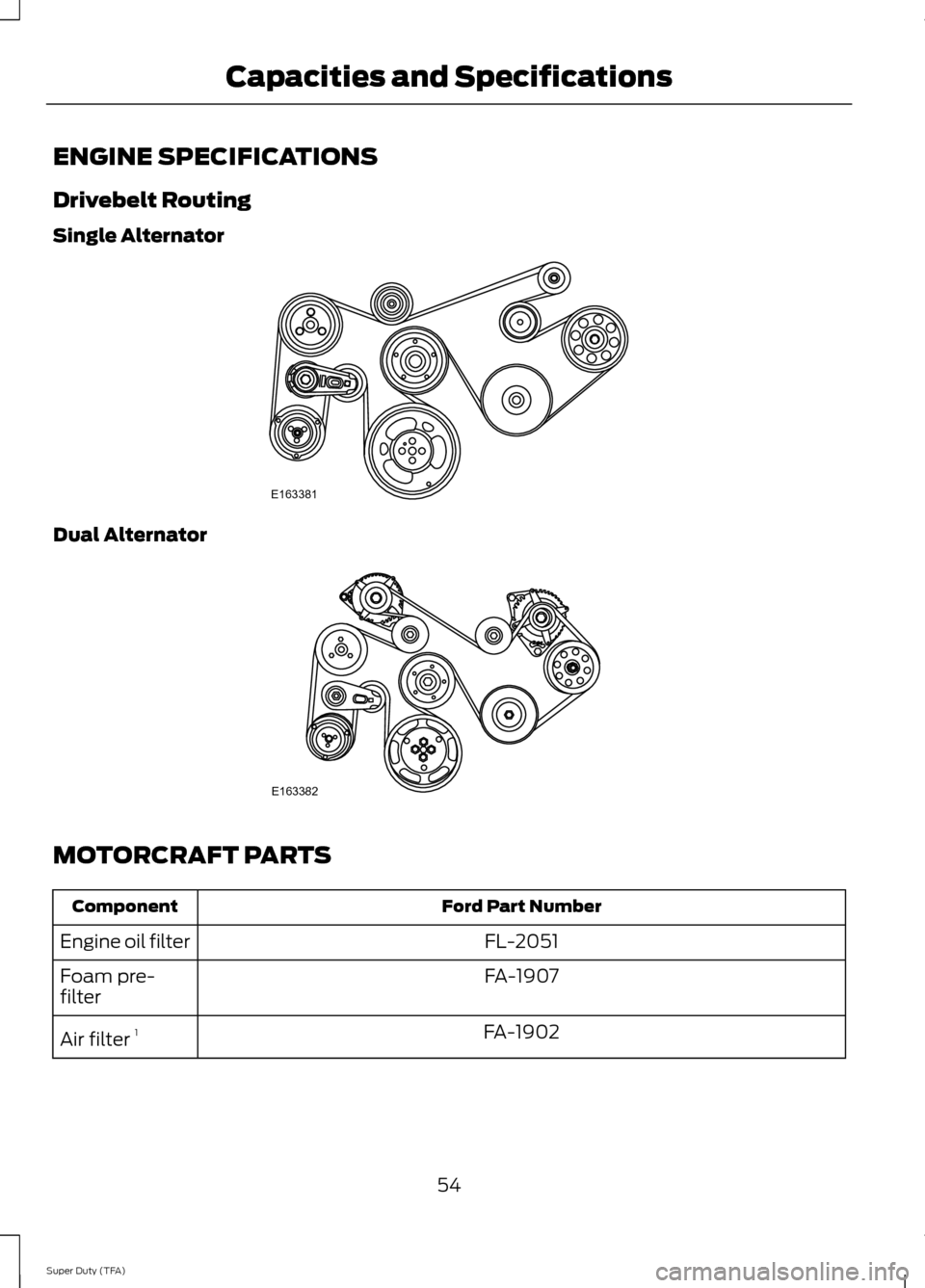
ENGINE SPECIFICATIONS
Drivebelt Routing
Single Alternator
Dual Alternator
MOTORCRAFT PARTS
Ford Part Number
Component
FL-2051
Engine oil filter
FA-1907
Foam pre-
filter
FA-1902
Air filter 1
54
Super Duty (TFA) Capacities and SpecificationsE163381 E163382
Page 58 of 82
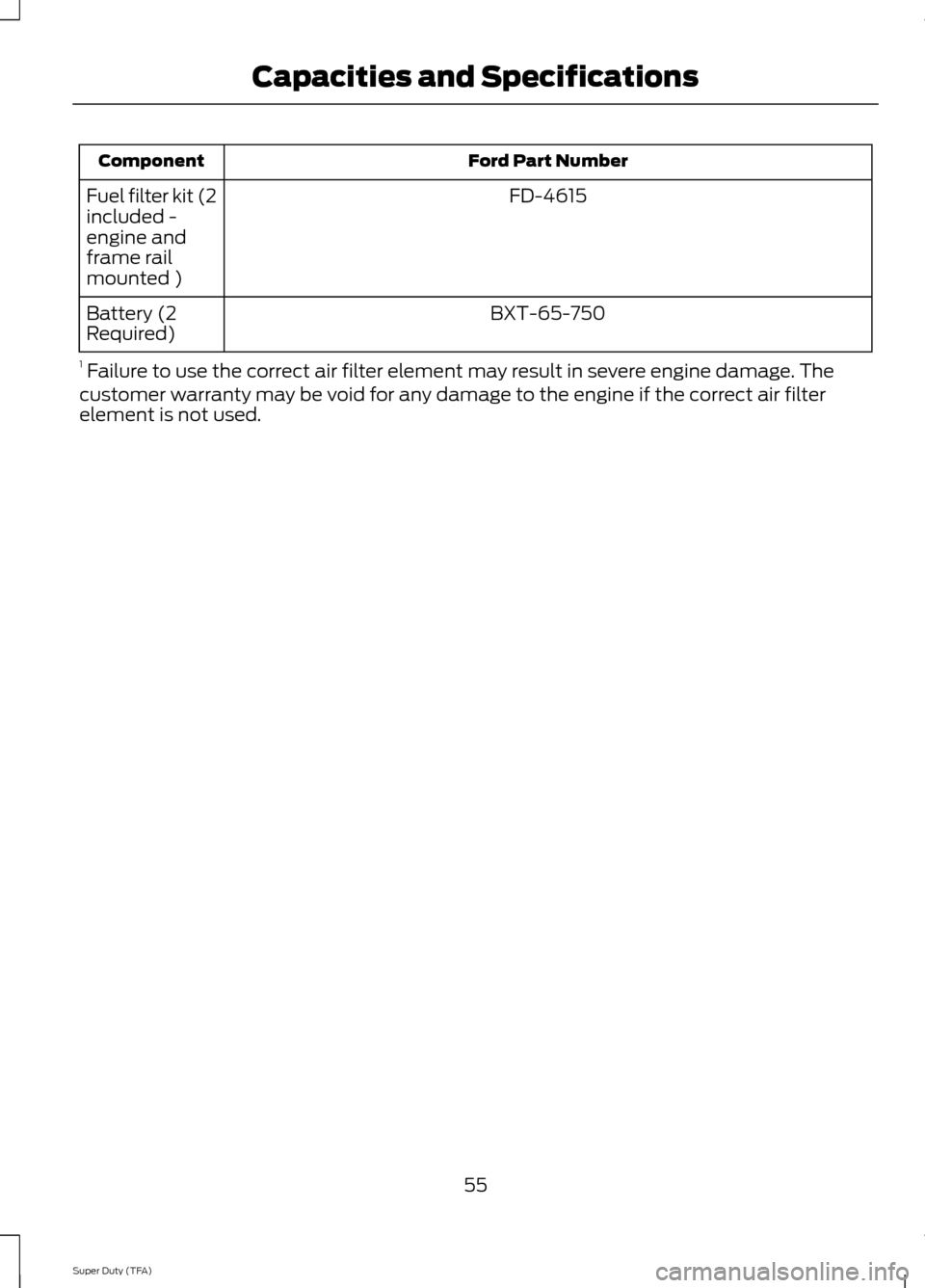
Ford Part Number
Component
FD-4615
Fuel filter kit (2
included -
engine and
frame rail
mounted )
BXT-65-750
Battery (2
Required)
1 Failure to use the correct air filter element may result in severe engine damage. The
customer warranty may be void for any damage to the engine if the correct air filter
element is not used.
55
Super Duty (TFA) Capacities and Specifications
Page 59 of 82
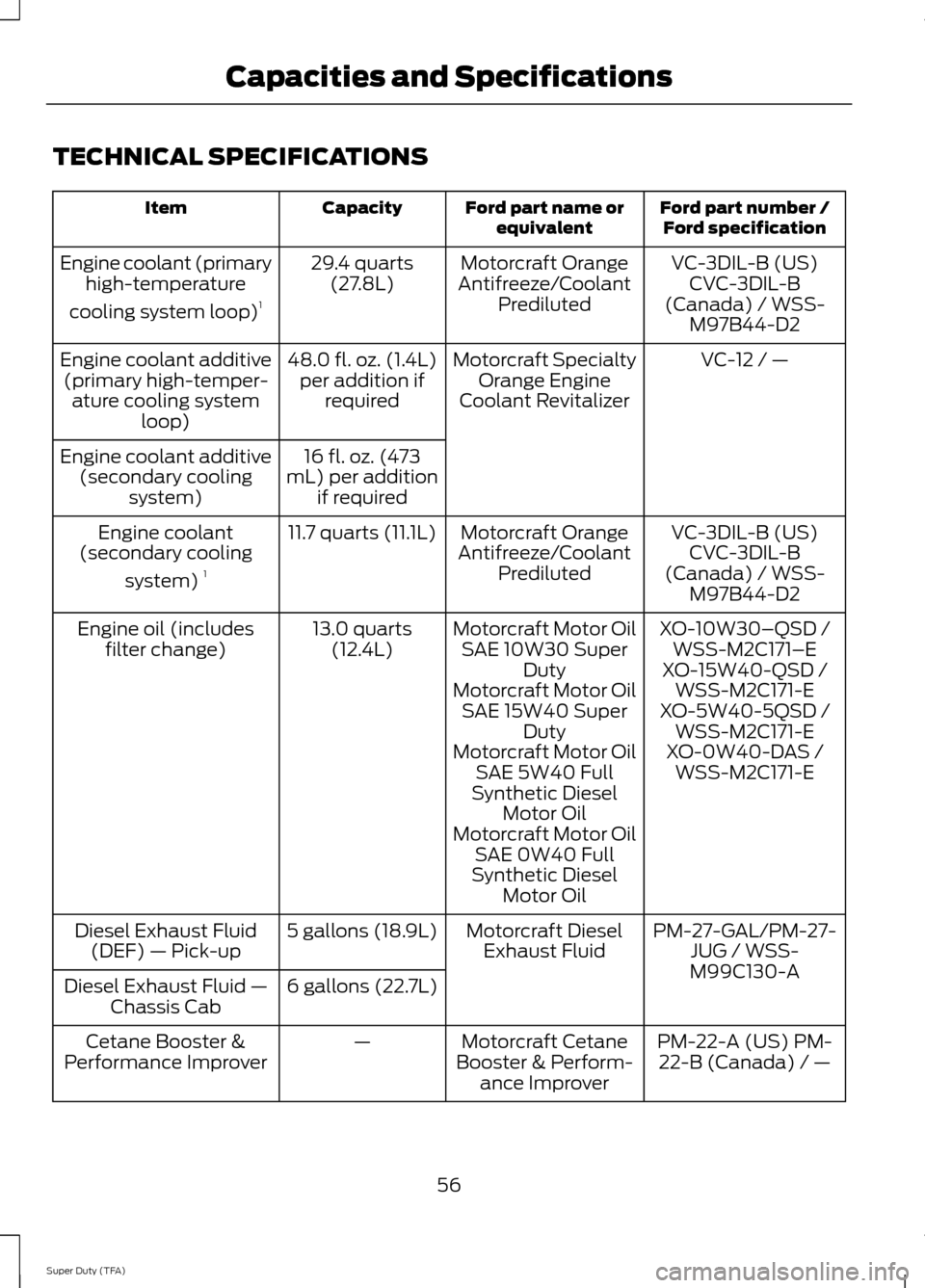
TECHNICAL SPECIFICATIONS
Ford part number /
Ford specification
Ford part name or
equivalent
Capacity
Item
VC-3DIL-B (US)CVC-3DIL-B
(Canada) / WSS- M97B44-D2
Motorcraft Orange
Antifreeze/Coolant Prediluted
29.4 quarts
(27.8L)
Engine coolant (primary
high-temperature
cooling system loop) 1
VC-12 / —
Motorcraft Specialty
Orange Engine
Coolant Revitalizer
48.0 fl. oz. (1.4L)
per addition if required
Engine coolant additive
(primary high-temper- ature cooling system loop)
16 fl. oz. (473
mL) per addition if required
Engine coolant additive
(secondary cooling system)
VC-3DIL-B (US)CVC-3DIL-B
(Canada) / WSS- M97B44-D2
Motorcraft Orange
Antifreeze/Coolant Prediluted
11.7 quarts (11.1L)
Engine coolant
(secondary cooling
system) 1
XO-10W30–QSD /WSS-M2C171–E
Motorcraft Motor Oil
SAE 10W30 Super Duty
13.0 quarts
(12.4L)
Engine oil (includes
filter change) XO-15W40-QSD /WSS-M2C171-E
Motorcraft Motor Oil
SAE 15W40 Super Duty XO-5W40-5QSD /
WSS-M2C171-E
Motorcraft Motor Oil SAE 5W40 Full
Synthetic Diesel Motor Oil XO-0W40-DAS /
WSS-M2C171-E
Motorcraft Motor Oil SAE 0W40 Full
Synthetic Diesel Motor Oil
PM-27-GAL/PM-27-JUG / WSS-
M99C130-A
Motorcraft Diesel
Exhaust Fluid
5 gallons (18.9L)
Diesel Exhaust Fluid
(DEF) — Pick-up
6 gallons (22.7L)
Diesel Exhaust Fluid —
Chassis Cab
PM-22-A (US) PM-22-B (Canada) / —
Motorcraft Cetane
Booster & Perform- ance Improver
—
Cetane Booster &
Performance Improver
56
Super Duty (TFA) Capacities and Specifications
Page 60 of 82
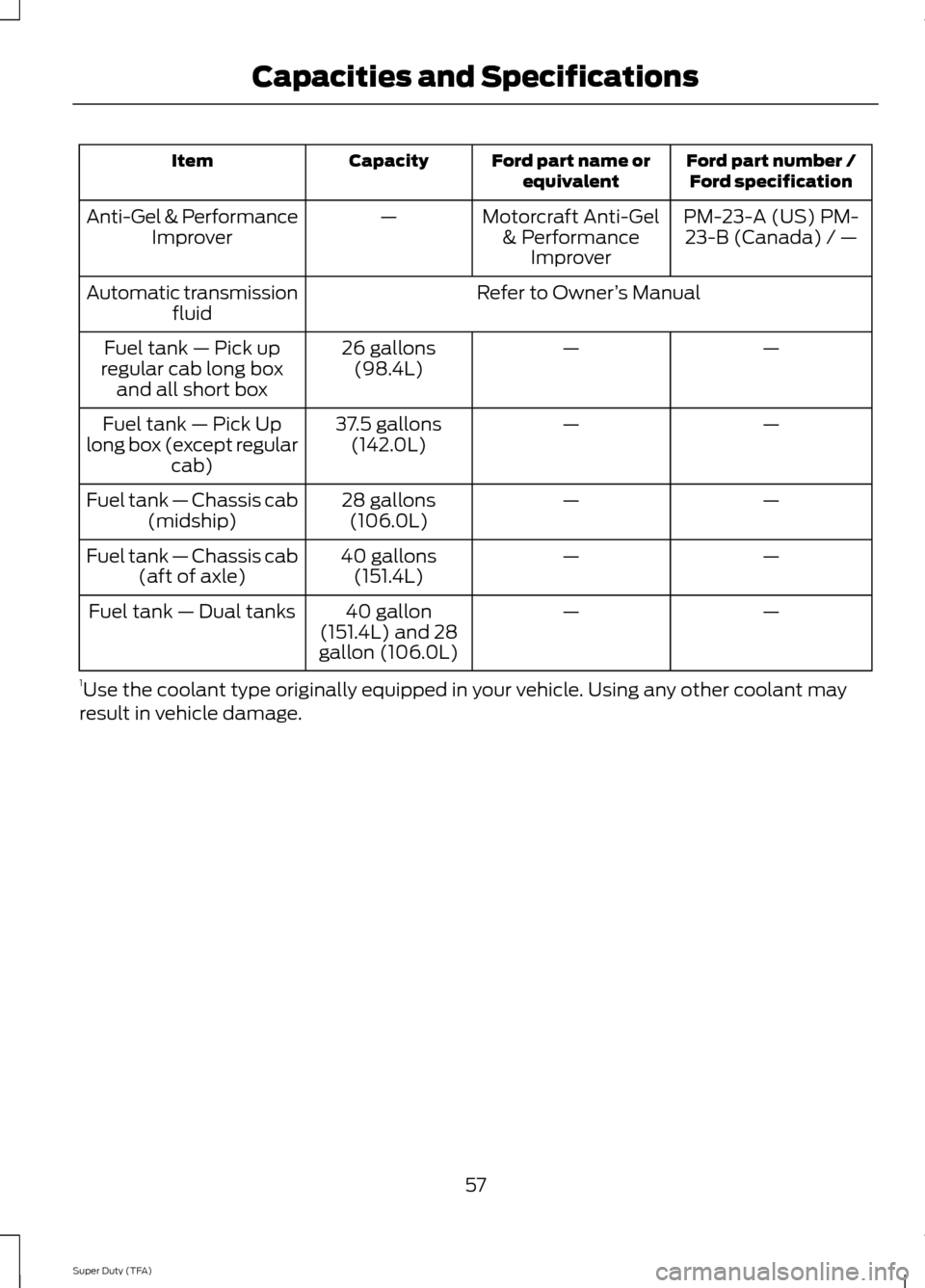
Ford part number /
Ford specification
Ford part name or
equivalent
Capacity
Item
PM-23-A (US) PM-23-B (Canada) / —
Motorcraft Anti-Gel
& Performance Improver
—
Anti-Gel & Performance
Improver
Refer to Owner’s Manual
Automatic transmission
fluid
—
—
26 gallons
(98.4L)
Fuel tank — Pick up
regular cab long box and all short box
—
—
37.5 gallons
(142.0L)
Fuel tank — Pick Up
long box (except regular cab)
—
—
28 gallons
(106.0L)
Fuel tank — Chassis cab
(midship)
—
—
40 gallons
(151.4L)
Fuel tank — Chassis cab
(aft of axle)
—
—
40 gallon
(151.4L) and 28
gallon (106.0L)
Fuel tank — Dual tanks
1 Use the coolant type originally equipped in your vehicle. Using any other coolant may
result in vehicle damage.
57
Super Duty (TFA) Capacities and Specifications